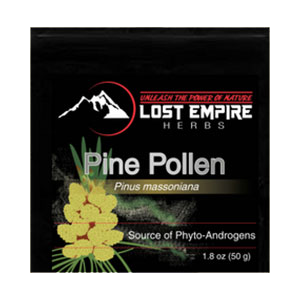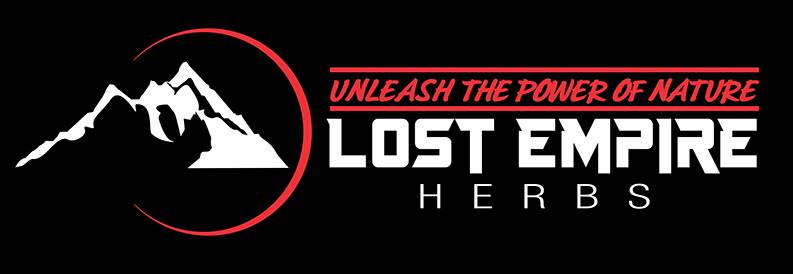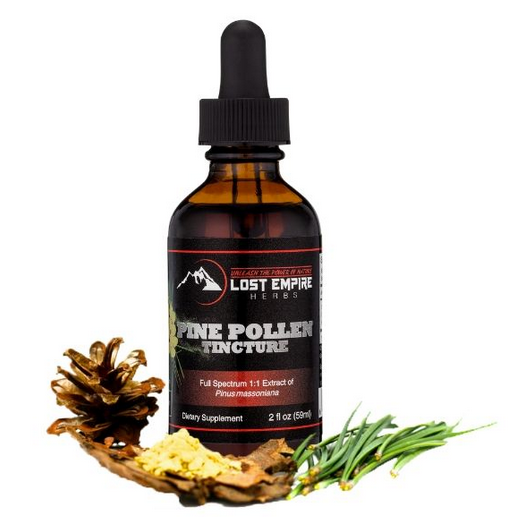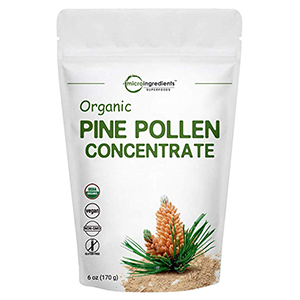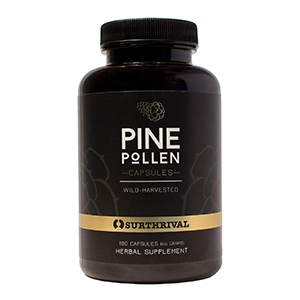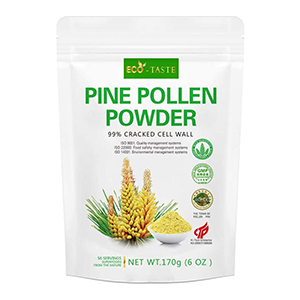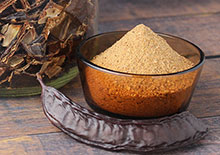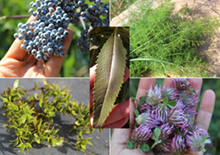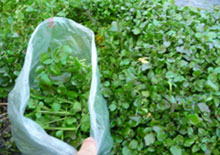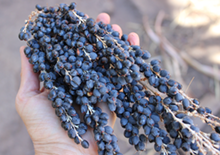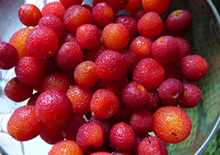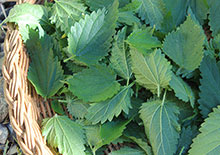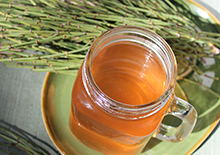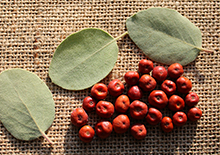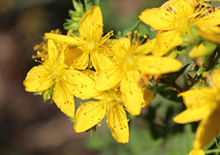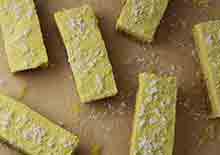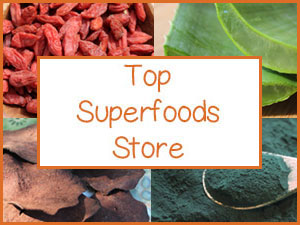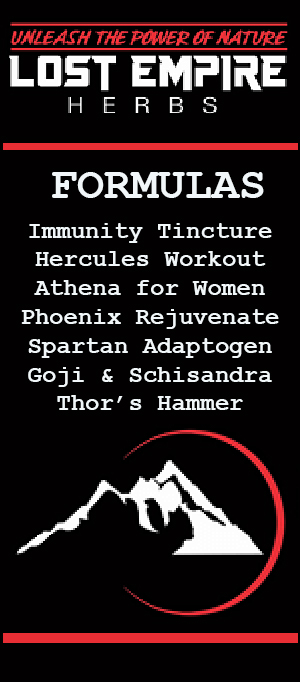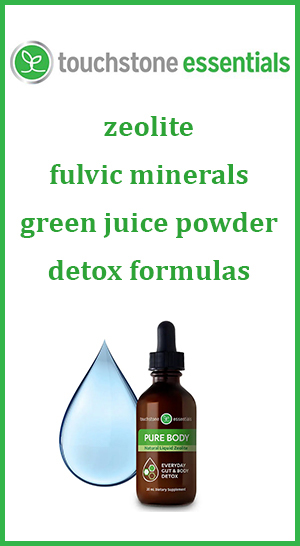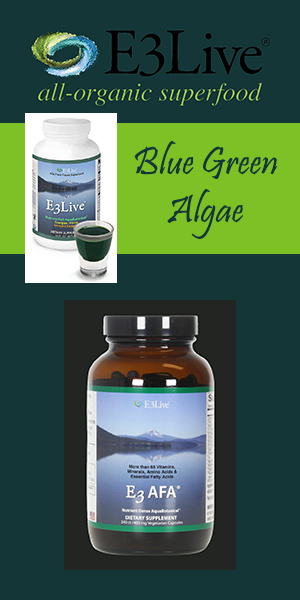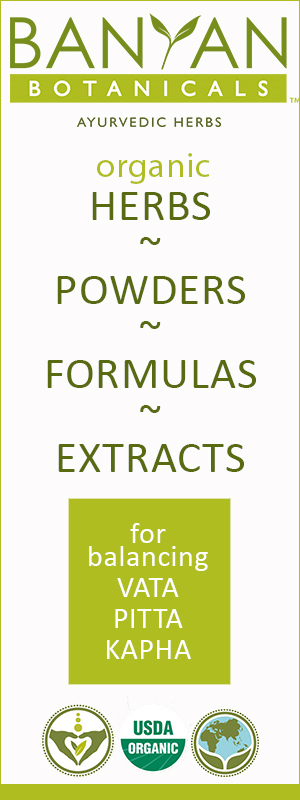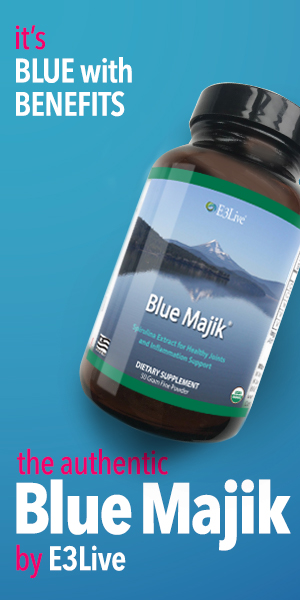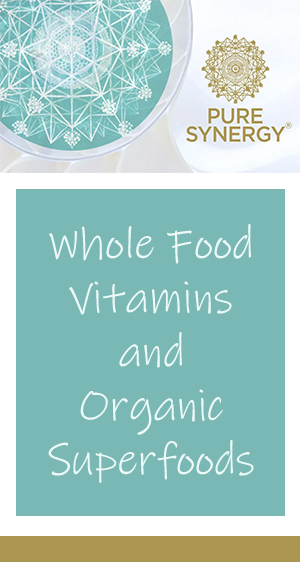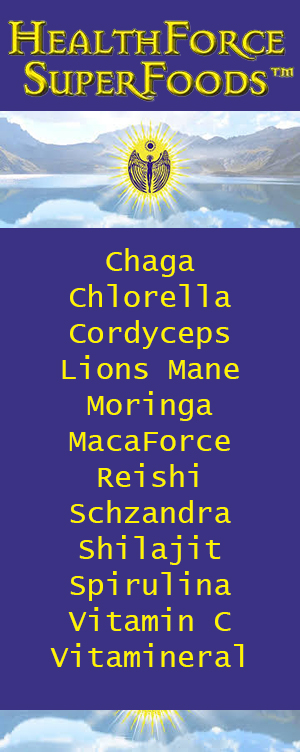- Home
- Wild Plant Foods
- Pine Pollen Benefits
Pine Pollen Benefits, The Superfood from the Pine Tree

Pine pollen benefits are well known these days in the "superfood world" as a nutritive adaptogen tonic powder collected from various pine tree species and consumed as a dietary supplement. It is most widely known for its supportive effects to endocrine and immune functions as well as its potential for increasing certain enzymatic antioxidants.
There are many types of pine trees growing all over the world, but one thing all species have in common is that they make pollen-saturated catkins. Here in the Sierra Nevada foothills, early spring is often the time when male "cones" are filled with these tiny grains. On a sunny day with the help of a nice breeze, the yellow powdery dust-like pollen will completely cover the ground and everything around it.
Pine pollen, coming from the genus Pinus, is usually wild harvested for commercial use from the Pinus sylvestris or Pinus massoniana pine tree species, both native to Asian countries with Pinus sylvestris also being indigenous to Western Europe. Pollen powder, however, can be collected from any pine tree species and is a very common seasonal occurrence found in large quantities in alpine environments.
Dusting the earth with its golden granules, the grains literally cover the landscape, which is often considered a nuisance to most people. The release of pollen is a natural part of the life and growth cycle of these ecosystems, feeding the soil, plants and animals who eat pollen dusted food sources. The phytosterols in the pollen can help to provide steroidal constituents useful for encouraging the springtime reproductive energy of many wild animals.
Valued for its significantly high amounts of
testosterone in addition to a complex of other androgens and
phytosterols, pine pollen benefits are known to help balance the ratio between the sex hormones, androgen and
estrogen.
The pollen is considerably more potent as an extract when taken for these purposes and can be specifically useful for middle aged adults, between 40-50, and the hormonal fluctuations that occur with the aging process. Men in particular, usually by the age of 50, produce substantially less testosterone. This is especially true after male "andropause".
Moreover, we are all subject to toxins in our environment that produce estrogen like qualities which are linked to a number of health conditions. Consuming androgenic foods, like pine pollen, might provide a balancing influence by counteracting the "xenoestrogens" commonly found in plastics, chemicals, pesticides and tap water sources.
Note: Generally,
pine pollen as a supplement is not recommended for children and should be avoided by male adolescences, who on
average naturally produce healthy amounts of testosterone. While pine pollens aren't normally the cause of allergies for most people, they can definitely induce this response in certain individuals and are best avoided internally under such circumstances.
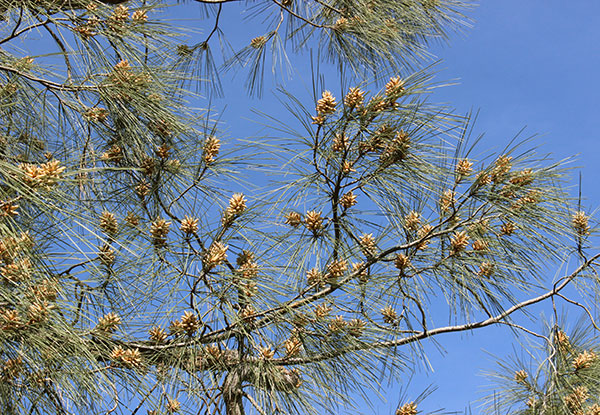


What is Pine Pollen?
There are close to 175 species in the genus Pinus and in the family Pinaceae, all of which produce pollen. Most commercial pine pollens are from the Pinus massoniana or Pinus sylvestris species. Pines are generally monoecious, which means they have male and female cones on the same tree.
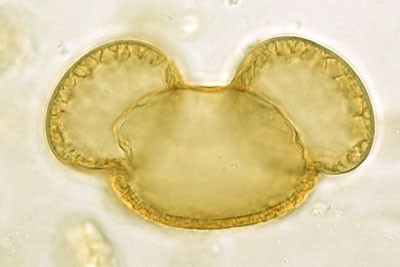
The pine tree pollen produced does not come from the female "pine cones" most people are familiar with, but from the male cone or "catkin", a softer spiky shoot that buds every year in early spring. This is what creates the pollen used to fertilize the growth of female pine cones.
The actual microscopic grains come in a few shapes and sizes, but typically are spherical and have a "mickey mouse-looking" shape when viewed under a microscope. The ears of the mouse being the "wings" of the pollen designed most likely to fly long distances through the air.
Many parts of the pine tree itself are edible or likewise have an herbal component. The pine needles, young shoots, resin, inner bark and of course pine nuts have all been used throughout human history. Native American populations considered pines and their abundance of food resources a sacred tree.
What is Cell-Wall Broken Pine Pollen?
Pine pollen straight from the tree, under the right circumstances, can be a nutritious top superfood with bioabsorbable constituents beneficial to health and immune functions.
Some companies, however, have found that broken cell-wall pine pollen is slightly more nutrient dense, providing up to 25% more digestibility. Breaking the cell-wall is commonly achieved, according to our research, by a high-speed airflow pulverization process which breaks up the cellular matter, making it more bioavailable to the body.

 Pine Pollen Dust
Pine Pollen DustPine Pollen History
The pollen was widely used by cultures throughout Asia, particularly China and Korea, for its nutritional value as well as a longevity tonic for boosting energy levels and building immune health. Mentioned in the Chinese text Shennong's Root and Herbal Classic, the earliest records of its medicinal use date back to the Han dynasty over 2,000 years ago.
Today it is still used in parts of China and Korea as a food product,
sold boxed like a common kitchen baking ingredient to be used like flour in baked goods and confections. Asian countries
dominate the pine pollen industry and, as a result, most wild pine
pollen products come from these locations.
Pine pollen's use and popularity here in the West is a fairly recent phenomenon and is due in part to herbalist and author Stephen Harrod Buhner and his books, "The Natural Testosterone Plan" and "Pine Pollen: Ancient Medicine for a New Millennium." Stephen Buhner writes, "Pine pollen given its potency, its similarity to ginseng in some of its actions, and its status as, perhaps, the premier phytoantrogen on the planet, should have been recognized long before now as the powerful medicinal that it is."
Difference Between the Powder and the Tincture
Pine pollen is commonly available as both a powdered supplement and tinctured extract. However, there is a bit of a difference between the two. The powder contains less androgenic substances but more of the other nutritive whole food qualities like vitamins, minerals and antioxidants. Pine pollen tinctures are significantly higher in androgens, like testosterone. This may be particularly relevant depending on your age or current health goals. Both are very beneficial but in different ways.
Purchasing High Quality Pine Pollen
Because China has an entire industry set up for harvesting and extracting the pollen, this is where most pine pollen products originate. Most all is wild harvested, so it is important that pollens collected come from a clean pollution-free environment.
Pine pollen products from Lost Empire Herbs (formerly Super Man Herbs) we have found to be a potent high quality source and are thus one of our top recommended suppliers.
Pine Pollen Benefits
Contains Testosterone for Androgen/Estrogen Balance
Pine pollen benefits offer one of nature's most potent sources of androgenic substances known in the plant kingdom, composed of the bioidentical steroid hormone testosterone, along with lesser amounts of other steroids including androstenedione, dehydroepiandrosterone (DHEA) and androsterone.
In an excerpt from the book "Pine Pollen, Ancient Medicine for a New Millennium" Stephen Buhner states that it is a "potent overall tonic to the body and its functioning, powerful nutritive and exceptionally effective androgen which raises testosterone levels in the blood and balances the androgen/estrogen ratio."
The words estrogen and androgen are general terms for the main class of sex hormones, which need to be biosynthesized in the appropriate way for optimizing certain endocrine functions. We mentioned androgens like testosterone and androstenedione, but this also includes the group of estrogens such as estrone, estriol and estradiol as well as the third class of sex hormones called progestogens, like progesterone.
Both men and women utilize both androgen and estrogen compounds, but androgens are produced in much greater quantities in males and likewise estrogen is produced in larger amounts in females, especially during the childbearing years.

When we have a healthy balance of these hormonal substances, things like weight gain, insomnia, fatigue, low sex drive, depression and more serious health conditions become less of an issue.
As we mentioned, pine pollen benefits as a testosterone booster can be exceptionally valuable to middle aged adults who produce significantly less testosterone, DHEA and androstenedione after the hormonal changes that come after male andropause and female menopause.
Note
When discussing ways to help balance the sex hormones, estrogens and androgens, there are many different complex mechanisms and pathways that may take place for any one individual. It is important that you do your own research and seek the advice of a qualified health practitioner or endocrinologist to help evaluate your own unique hormone profile.
How to Avoid Aromatization
Some factors, like the process of aromatization, which can break down androgens and turn them into estrogens, can be a problem for some people. It is therefore significantly important that the testosterone consumed in pine pollen stays "free" and doesn't aromatize and convert to estrogen.
One way many herbalists and health experts recommend to do this is to use stinging nettle root along with pine pollen in alcohol extracts. Nettle root is a natural aromatase inhibitor which has the reported ability, due to its beta-sitosterol content, to bind with the protein SHBG or the sex hormone binding globulin. This promotes the circulation of free testosterone in the body so it can be utilized as an androgenic molecule rather than as an estrogen. (Source)
As we mentioned, the tinctured extracts are more concentrated in bio-available androgens, compared to the raw fresh or cell-wall broken powders. Other testosterone supporting superfoods, including maca, tribulus, ashwagandha, ginseng, cistanche and fenugreek, are often used along with pine pollen in commercial plant-based testosterone supplements.
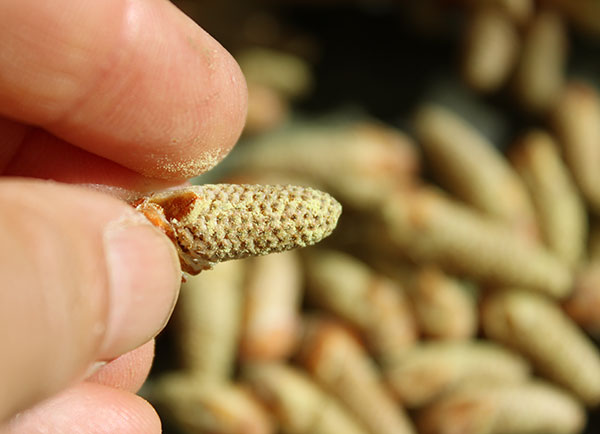
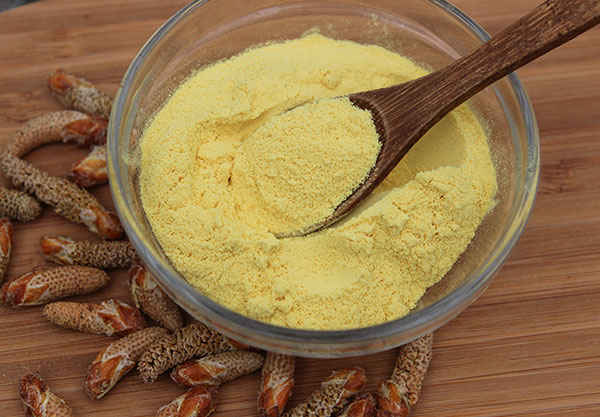
Androgens Counteract the Effects of Xenoestrogens
We live in an estrogen dominant modern-day environment, exposed to countless man-made estrogens sourced from petroleum or chemical substances such as herbicides, pesticides, plastics, BPA, dioxin and PCB's.
Xenoestrogens, also known as the "bad estrogens", are created from these toxic substances, most of which humans come into contact with on a daily basis. These residues tend to bind to our estrogen receptors, in both men and women, and mimic estrogen and block normal hormonal functioning.
This can cause an over-dominance of estrogens in both males and females and a subsequent drop in androgen levels, potentially leading to breast and prostate issues, fibroid growths and infertility. Supplementing with a pine pollen tincture might be useful to help counteract this estrogen dominance and support a normal androgen/estrogen balance.
Good for Athletes and Body Builders
As a natural testosterone source, abundant in anabolic phytosteroids, pine pollen benefits are also considered helpful to body builders or athletes for increasing muscle mass and improving endurance and overall performance. In addition, it comes without the potential side-effects common with synthetic anabolic-androgenic steroids.
Enhances Libido, Will Power and Mood
Pine pollen tinctures as well as the powders can be used as an aphrodisiac to help elevate sex drive and sustain healthy libido levels for both men and women with lower testosterone ratios.
Because men require more androgen hormones than women do, it is predominately considered a male supplement that can have a positive influence on certain health concerns like erectile dysfunction.
Testosterone is not only good for increasing sex drive but also helps to
promote feelings of well-being, uplifts the mood and stimulates a sense
of will power and enthusiasm for life. Containing a substance called
phenylalanine, an L-dopa precursor which helps to stimulate dopamine levels in the brain, it is additionally believed to act as a natural antidepressant.

Immune Boosting Components and Other Nutrients
Pine pollen powder, either in its raw natural state or as a cell-wall broken supplement, is considered a highly nutritious food providing a broad spectrum of vitamins, minerals, all essential amino acids and immune system boosting antioxidants. Containing folic acid and other B vitamins, beta-carotene, Vit. E, selenium, calcium, iron, magnesium, nucleic acids, living enzymes, MSM, polysaccharides, essential fatty acids and was also shown in one study to be a source of vitamin D3.
As an adaptogen, it may also help us build resistance to daily stress, acting as a potential restorative for boosting immune health.
Pine
tree pollen increases the beneficial antioxidants, like glutathione and
SOD or superoxide dismutase. Glutathione is necessary for the
metabolism of certain vitamins and minerals, like iron, Vit. C, Vit. E
and is involved in amino acid transport. It also inhibits cancerous
growths, neutralizes free radicals and is important for DNA synthesis
and production. Moreover, glutathione contains the enzyme, glutathione
S-transferase, which is a liver-detoxifying enzyme.
Another of pine pollen benefits is that it supports the healthy production of SOD which typically tends to diminish as we grow older. Superoxide dismutase is an anti-aging nutrient and natural antioxidant enzyme produced within the body and plays a significant role as a free radical scavenger that also protects against DNA damage.
Pine Pollen Benefits for Skin
Pine pollen contains the amino acid arginine as well as sulfur-based MSM, both of which are beneficial in the treatment of various skin conditions. Sulfur furthermore helps to build keratin and collagen, two compounds essential for healthy nails, hair and skin tissue. The powder can be used externally by adding it to a salve or cream and used for eczema, rashes or even acne.
Androgen steroids also help to optimize tissue regeneration and prevent the
degradation of collagen and elastin, two important constituents for maintaining healthy skin. The pollen is known among Asian women for its beautifying effects, contributing to smooth and youthful looking skin, when used both topically or consumed as a powder.
MSM Acts as an Anti-Inflammatory
Because the pollen is comprised of the mentioned sulfuric compound known as MSM, it additionally acts as a powerful natural anti-inflammatory agent and pain reliever, especially for the joints and conditions like arthritis. In several studies conducted using extracts on arthritic subjects, results suggested its usefulness as a beneficial treatment for chronic inflammatory disorders.
Other pine pollen powder components like gibberellins and SOD also both play a critical role in reducing inflammation in the body.

Harvesting Your Own Pine Pollen
If you happen to live in an alpine conducive environment, you can actually collect your own pine pollen for FREE in nature's garden. We are huge advocates of wild harvesting your own superfoods whenever possible. Pine pollen is easily collected within a 3 week time frame in early spring to early summer, depending on the elevation.
In California, mid to late March is pine pollen season for alpine elevations around 2,500 to 3,000 feet. Higher elevations, for example near Tahoe California, can drop pollen in mid to late June.
The pollen is best harvested when the catkin is packed full, usually a 3-7 day period. When planning to harvest you should be aware of potential weather conditions, like rain or wind, which may affect your harvest. Also, it is best to harvest when the sun is shining, rather than on a cloudy day as the cones respond to moisture and cold temperatures by closing up to hold in pollen grains.
Techniques for Harvesting the Pollen
The basic technique for manually harvesting your pollen is to wrap a large bag around the male cone catkin, or entire branch of them, and shake it vigorously so that the powder falls to the bottom of the bag, of course keeping a tight grip on the bag opening while you do this.
The other more common method is to cut off the catkins at
the base, remove the individual
shoots, place them in strainer half full with a secured lid on top and shake out
the pollen in a large enclosed bag. The golden-yellow grains will collect in the bottom of the bag and can be poured out and filtered one more time through a fine mesh strainer.
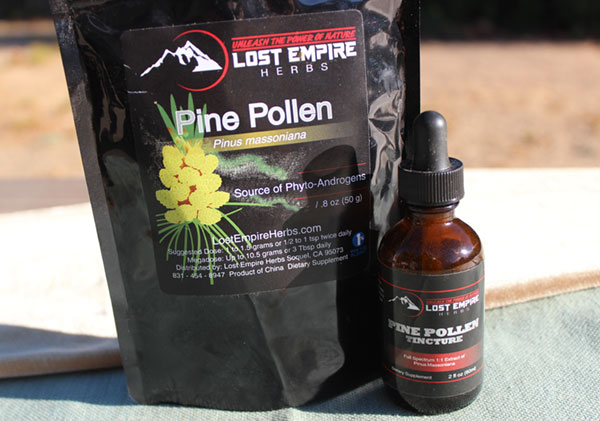
Types of Pine Pollen
- Fresh Harvested - Fresh raw powder collected from male pine catkins.
- Bulk Powder - Powders sold commercially, most are cell-wall broken for increased absorption.
- Capsules or Tablets - The powder encapsulated in gel caps or compressed into tablet form.
- Extracts - Tinctured alcohol-based pine powder solution, comes in different strengths.

How to Use
The powder has a mild "piney" flavor and can be consumed with other foods, blended into drinks or mixed in water. In can also be added to various desserts like a flour ingredient, which is often the way it is consumed in parts of Asia.
We advocate wild harvesting your own pine pollen if you live in an alpine environment. Again, you can use the fresh pollen as a powder or make an alcohol tincture. Using other herbs like nettle root, passion flower or Japanese knotweed in the tinctured formula is advised as these aromatase inhibitors will encourage the absorption of "free" testosterone.
Depending on your unique health goals, you may want to take either the tincture, the powder or both. The tincture being more effective for boosting testosterone and the powder being more nutritious in other ways. When consuming the tincture, it is best to hold it in the mouth or under tongue for at least a minute before swallowing. This increases the amount that is taken into the bloodstream.
When supplementing with pine pollen tincture or powder it is best to take short breaks and avoid taking it at the same time every day.
It is best to always follow dosage recommendations on specific product labels.
Precautions
Those with asthma or specific allergies to pollen, pregnant or nursing should avoid using pine pollen internally or seek the advice of a physician before supplementation. Pine pollen products are contraindicated for young adolescent males, infants and children. Consult your healthcare provider before consuming pine pollen if you have a serious health condition or are taking prescription medications.
Shop Related Products (About Affiliates & Amazon Associate Paid Links)
Affiliate Disclaimer: This section contains affiliate product links. If you make a purchase through our recommended links, we receive a small commission at no additional cost to you. Thanks for the support.

